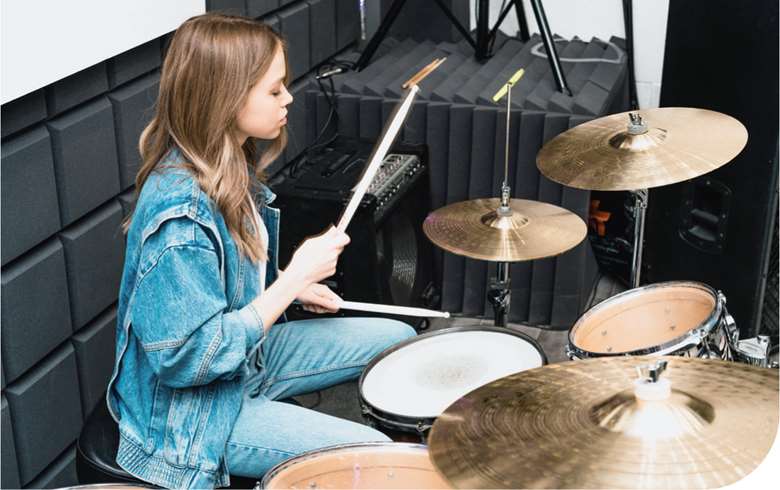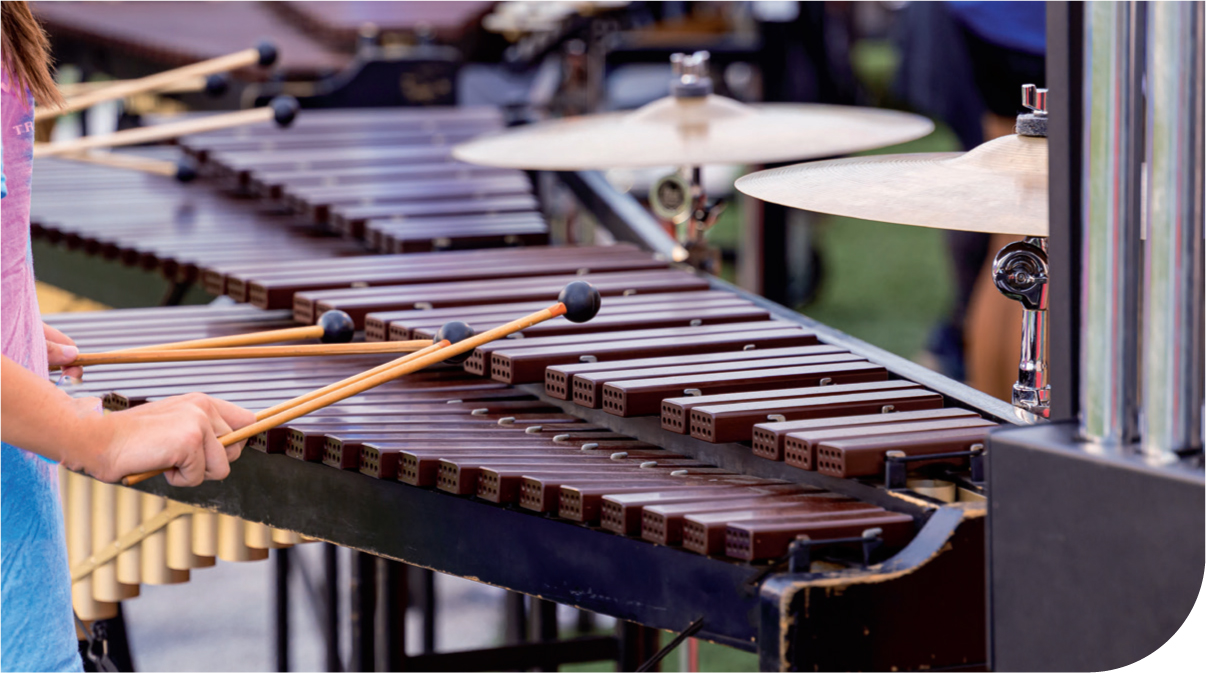The perils of percussionists
Anne Templer
Thursday, July 1, 2021
As a seasoned player herself, Anne Templer good-humouredly sets straight a few stereotypes about percussionists and provides some useful guidance for ensuring that all your young instrumentalists are equally supported in their playing

Natalya Lys/AdobeStock
It has often been assumed that percussionists are the most unmusical and least educated members of the musical diaspora, and that's putting it politely. Personally, I have never particularly minded this label; for a start there is a grain of truth in it (I am yet to hear a percussionist discussing Schenkerian analysis, for example – somebody would probably punch them if they did). Percussionists are more likely to have been raised on funk grooves than Brahms, rock rhythms than Schubert. Their musical education is likely to have had depth, sure, but the very nature of all things you hit, scrape or shake will mean that they have to have a broader range of skills, are literally required to play more instruments, and will often have to wing it. A degree of improvisation has to be part of their DNA and their thinking requires speedy decisions rather than an in-depth exploration of the recapitulation.
Similar assumptions can also be made about selecting appropriate students to learn in the first place. I have often been asked to teach a child who is ‘a bit of a handful,’ ‘not very bright’ (though usually a more subtle form of words is found), or perhaps ‘good at rhythm’ which is often code for ‘not very musical’ (again, with appropriate linguistic vagueness).
The unmusical label is trickier to handle but is at least something you can shock people with. I have experienced far more examples of this than could possibly be listed here, but here are two passing but truthful illustrations: Firstly, in my questioning the interval of a tri-tone at a rehearsal my (wind-playing) colleague was stunned into silence. Pleasingly, he had the presence of mind to make a joke of it: ‘A percussionist with an ear – how dare you!’
The second was with a dreadful conductor who, when questioned by me over the second violins persistently playing wrong accidentals in the middle of a texture, had no response at all, except for ‘err…’ and a hasty retreat. I wasn't being deliberately malevolent – just irritated at the sloppiness and was struggling to tune the timps because of it. Actually, malevolence with a sniff of irony can be really funny and, taken with the right spirit, can be really bonding for a team of players. It is true that percussionists can often be the type of musicians who enjoy jokey banter or get bored easily (guilty as charged) or don't necessarily ‘settle’ very well on other instruments. But I prefer to think of them as musically diverse, rather than suffering from poor concentration or a lack of creative instinct.
 © Leo Previtali/ AdobeStock
© Leo Previtali/ AdobeStock
‘Dangerous precedents’
My point is that there can be terribly lazy assumptions about percussionists. All too often I have seen musical directors stand at the front and say, ‘I know nothing about percussion’ – not with embarrassment, but with pride. The trouble with such ignorance is that crazy expectations are made of the players; you can't start a rehearsal in a ‘tutti’ section with percussionists on several different instruments if they haven't yet worked out the distribution of parts, sticks, instruments and hadn't been told of the repertoire beforehand, for example. Being told to ‘sort yourselves out’ – particularly when it comes to children – is not only unhelpful, but also sets some dangerous precedents.
Consider, for example, the conductor who implies that the ‘loudest’ child should play the kit or the snare drum. Where does that leave us? Potentially with the most confident personality – but not necessarily the best player – thrashing around. Also, gender stereotypes continue to persist. There remain too many examples of girls being pushed to the tuned percussion parts and left there. This can occasionally be dressed up as, ‘she is the tuned specialist,’ but is essentially unfair and sloppy decision making.
Ideally, instruments should be rotated, but also players shouldn't necessarily be allowed to get away with saying they ‘can't’ play something. Students can be encouraged to challenge themselves and look to widen their boundaries. If there is a simple glockenspiel part, for example, anyone can play it and an alternative student who wouldn't otherwise have the chance can attempt the snare drum or kit part.
 © Mark/AdobeStock
© Mark/AdobeStock
Next steps
As the need to embrace percussion in most ensembles is almost inescapable, here are some suggestions for navigating this mysterious world:
- If you are not a percussionist and are intimidated by the thought of handing out tips to students, try and get some advice from a colleague. It is impossible to know everything about every instrument and continuing to exchange musical information is always useful.
- If you are conducting a wind band, it is likely that there will be lots of percussion parts, so decide which are your priority. A lot of education-based arrangements have extra ‘padding’ for those ensembles who are in the happy position of having multiple players.
- Try and avoid putting a child who has never had a percussion lesson in the section. The result can often be humiliation for the child and an instrument incorrectly played, resulting occasionally in damage to the instrument and often frustration all round. There are, of course, exceptions to this; as a percussion coach, I have from time to time been asked to accommodate pianists or guitarists, which – if they can read – is doable. Bear in mind that this is because they can be guided by someone who has expertise and the students themselves are able to follow the score. Try and do this sparingly; I have been asked to find parts for up to eight non-percussionists before – all at once.
- Understand that the parts will almost certainly not be presented in the form of a percussion ‘score,’ so if someone is looking at, say, a snare drum part, they are unlikely to be aware of what is going on in the tuned percussion.
- Remember that percussionists are essentially soloists; if they go wrong, it is likely to be visible and audible, so try to be kind.
- While there is increasing agreement on how to write percussion parts for all the instruments, not all manuscript is the same. Snare drum parts, for example, are meant to be written on the third space up on the stave, but I have seen them all over the place. Some are frankly appalling. Be prepared to edit ruthlessly.
- Encourage your players to work as a team. This is not the same as one person hogging all the exciting instruments, but may involve a sensible distribution of parts, playing to their strengths with an eye on stretching them a little.
- Drum kit parts are often unnecessarily complicated and can usually be simplified down to a straightforward groove, punctuated with appropriate fills. It's worth talking to a drummer about this, and also having an idea of the feel of a piece. Is it a pop ballad? Is it a Latin piece? Is it a march? If there are multiple tempo and stylistic changes, then the conductor needs to be very clear about this.
- If more ‘serious’ symphonic repertoire is being rehearsed, there is a chance that percussionists will have ample free time. I always advise students that this is the nature of the beast. Equally, however, it is helpful if directors plan rehearsals carefully. A useful hint is to tell players the order before starting the rehearsal so that appropriate setting up and organisation can take place.
- Be mindful of the fact that percussionists are rarely, if ever, playing their own instruments. In some instances, the differences between models are stark; timpani for example can be tuned in a multitude of different ways depending on the mechanism. Once again, students have to get used to this, but may need some time to adapt.
Finally, I recognise that we are in the real world here, and time and resources are stretched. Much of what has been written above is in an ideal scenario, but nevertheless requires consideration and planning. Adding well-rehearsed and sensitive percussion can really lift an ensemble to a much more exciting level. And don't forget – audiences love it.

